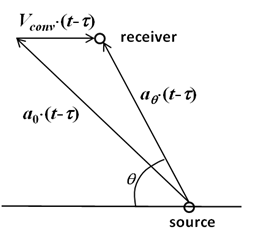The Ffowcs Williams and Hawkings (FW-H) equation is essentially an inhomogeneous wave equation that can be derived by manipulating the continuity equation and the Navier-Stokes equations. The FW-H [79] , [178] equation can be written as:
(11–1) |
|
where | |
|
| |
|
| |
|
| |
|
| |
|
| |
|
|
is the sound pressure
at the far field (
).
denotes a mathematical surface
introduced to "embed" the exterior flow problem (
) in an unbounded space, which facilitates
the use of generalized function theory and the free-space Green function
to obtain the solution. The surface (
) corresponds to
the source (emission) surface, and can be made coincident with a body
(impermeable) surface or a permeable surface off the body surface.
is the unit
normal vector pointing toward the exterior region (
),
is the far-field
sound speed, and
is the Lighthill
stress tensor, defined as
(11–2) |
is the compressive
stress tensor. For a Stokesian fluid, this is given by
(11–3) |
The free-stream quantities are denoted by the subscript
.
The wave equation Equation 11–1 can be integrated analytically under the assumptions of the free-space flow and the absence of obstacles between the sound sources and the receivers. The complete solution consists of surface integrals and volume integrals. The surface integrals represent the contributions from monopole and dipole acoustic sources and partially from quadrupole sources, whereas the volume integrals represent quadrupole (volume) sources in the region outside the source surface. The contribution of the volume integrals becomes small when the flow is low subsonic and the source surface encloses the source region. In Ansys Fluent, the volume integrals are dropped. Thus, we have
(11–4) |
where
(11–5) |
(11–6) |
where
(11–7) |
(11–8) |
When the integration surface coincides with an impenetrable
wall, the two terms on the right in
Equation 11–4
,
and
, are often referred to as thickness and loading
terms, respectively, in light of their physical meanings. The square
brackets in
Equation 11–5
and
Equation 11–6
denote that the kernels of the integrals
are computed at the corresponding retarded times,
, defined as follows,
given the receiver time,
, and the distance to the receiver,
,
(11–9) |
The various subscripted quantities appearing in
Equation 11–5
and
Equation 11–6
are the inner products of a vector and a unit vector implied
by the subscript. For instance,
and
, where
and
denote the unit vectors in the radiation and wall-normal directions,
respectively. The Mach number vector
in
Equation 11–5
and
Equation 11–6
relates to the motion of the integration surface:
. The
quantity is a scalar product
. The dot over a variable denotes source-time differentiation of that
variable.
For the calculation of the aerodynamic sound caused by external
flow around a body, the
Convective Effects
option
must be enabled (see
Setting Model Constants
in the
User's Guide
) with the far-field fluid
velocity vector
to
be additionally specified. This option is relevant to practical situations
such as the flight tests (microphones mounted on an airplane) or wind
tunnel measurements (microphones mounted within the wind tunnel core
flow region).
With the convective effects taken into account, the retarded
time calculation becomes more complicated than the simple form of
Equation 11–9
. As illustrated in
Figure 11.1: Schematic of the Convective Effect on the Retarded Time Calculation
, the effective sound propagation
velocity
is lower than
in the upstream hemisphere and higher than
in the downstream hemisphere, where
is the direction angle
towards the receiver counted from the upstream direction. According
to
Figure 11.1: Schematic of the Convective Effect on the Retarded Time Calculation
the retarded time with the
convective effect must be computed as
(11–10) |
An obvious limitation
for the
Convective Effects
option is that the
far-field convection must be subsonic
Note the following remarks regarding the applicability of the FW-H integral solution:
The FW-H formulation in Ansys Fluent can handle rotating surfaces as well as stationary surfaces.
It is not required that the surface
coincide with body surfaces or walls. The formulation permits source surfaces to be permeable, and therefore can be placed in the interior of the flow.
When a permeable source surface (either interior or nonconformal sliding interface) is placed at a certain distance off the body surface, the integral solutions given by Equation 11–5 and Equation 11–6 include the contributions from the quadrupole sources within the region enclosed by the source surface. When using a permeable source surface, the mesh resolution must be fine enough to resolve the transient flow structures inside the volume enclosed by the permeable surface.



